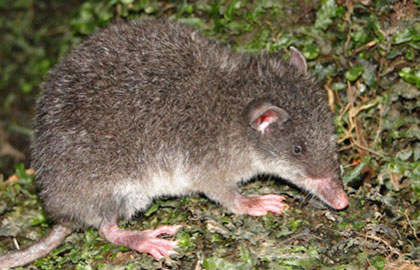Scientists discover new species of enigmatic marsupial
Along the eastern slopes of the Andes Mountains in Ecuador, Reed Ojala-Barbour ’11 and a team of scientists discovered a new species of shrew-opossum.
Their dive into discovery started more than two years ago, when Ojala-Barbour had undertaken a Fulbright Fellowship to study mammals of Sangay National Park.
The remote mountain park is located on the eastern slopes of the Andes. Among the mammals that Ojala-Barbour studied, this shrew-opossum did not well match the descriptions of the known species.

The new species of shrew-opossum, Caenolestes sangay, looks like a large mouse with small ears and a long snout.
According to Ojala-Barbour, “There were some morphological clues that indicated this marsupial could be different from its known relatives. The most similar species lives on the western slopes of the Andes, so our first guess was that we found a geographic variant. We concluded, however, from the morphology of the skull and the DNA, that this is a different species.”
Their discovery was recently published in the Journal of Mammalogy, a renowned scientific outlet for studies on the biology of mammals. In it, the international team of scientists from Ecuador and the U.S. described a new species found in the cloud forests of Sangay National Park and clarified the family tree of this group.

Reed Ojala-Barbour ’11. (Photo by John Froschauer)
The new species of shrew-opossum, Caenolestes sangay, looks like a large mouse with small ears and a long snout. Despite its looks, it is not a rodent or a shrew, but a marsupial without a pouch to carry its babies. Caenolestes sangay is part of the order Paucituberculata, an ancient group of South American marsupials different from the well-known opossums and Australian marsupials. Restricted to the Andes, very seldom seen in the wild, and with only seven species, the shrew-opossums are among the most enigmatic marsupials on the planet.
The DNA clearly delimits Caenolestes sangay as a different species, showing that this poorly studied group of marsupials is more diverse than previously thought. “It is possible that the diversity in this group will increase as more studies are conducted with Colombian, Ecuadorian and Peruvian material,” says Bruce Patterson, a curator at the Field Museum of Natural History.
This discovery of this new species is not an isolated event. Miguel Pinto, a Ecuadorian graduate student at the City University of New York and co-discoverer of the Olinguito carnivore as well as Caenolestes sangay, says, “The Andes are still terra incognita; several plants and animals remain to be described and studied in detail.” The co-authors of the article, including Ojala-Barbour and Pinto, have more projects coming unveiling the mammalian richness of the Sangay National Park.
The cloud forests in the Andes Mountains are very sensitive environments. These forests are under extensive human pressures, particularly farming and development. For example, Sangay National Park is threatened by land conversion associated with a new highway that bisects the park.
The article, “A new species of shrew-opossum (Paucituberculata: Caenolestidae) with a phylogeny of extant caenolestids,” Journal of Mammalogy, Vol. 94, No. 5, October 2013


